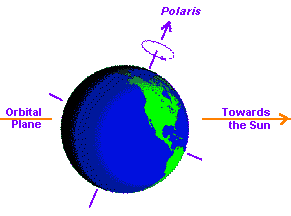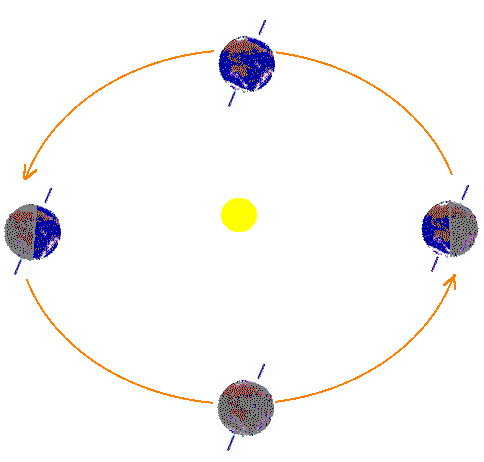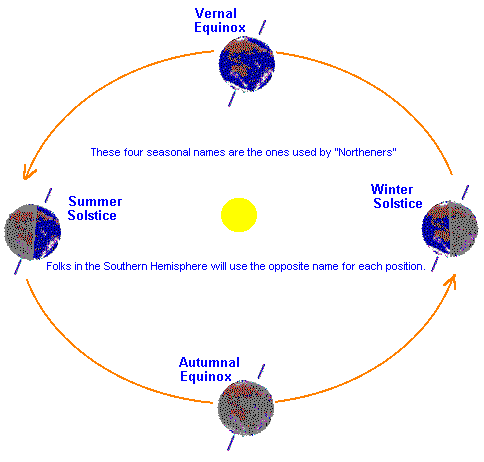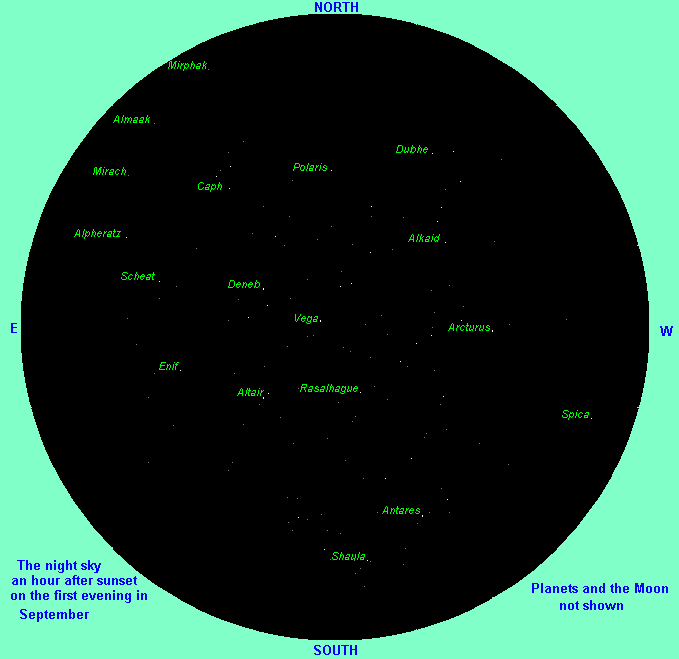The equinox occurs this month and signals the end of summer.
Summers are fun and a great time to get outside and enjoy those
warm summer nights so you might think that our fun would be coming
to a close with the end of summer. Nothing could be farther from
the truth. Autumn is on the way and with it comes shorter periods
of daylight and longer periods of nighttime. Astronomers and vampires
love long nights.  But what causes these seasonal changes in our
observation time and, for that matter, what causes our seasons?
The answer - the Earth is tilted! Without this tilt our lives
would be so much simpler - and boring.
But what causes these seasonal changes in our
observation time and, for that matter, what causes our seasons?
The answer - the Earth is tilted! Without this tilt our lives
would be so much simpler - and boring.
|
The tilt of the Earth causes
not only our seasons but also dictates our astronomy viewing habits
because it affects the length of out nighttime. So, how does it
all work?
The rotational axis of the Earth is defined by how the Earth rotates. This axis is constantly pointing its northern pole towards Polaris, the North Star. The Earth's orbital plane is the (flat) plane it "draws" in space as it orbits around the Sun. You might expect that the Earth's rotational axis would be perpendicular to its orbital plane but you would be wrong! The rotational axis of the Earth is NOT aligned at 90 degrees from its orbital plane - it's tilted 23.5 degrees from the "vertical". Indeed, most bodies in the Solar System have an "inclined rotational axis", meaning their rotational axis is not perpendicular to their orbital plane. |  |
Because of this tilt, as the Earth orbits the Sun the amount of sunlight falling on each hemisphere changes and the daily path of the Sun through the sky also changes.
|
This diagram might help
you understand. I have shaded the night side of the Earth(s) in
this image to help you to imagine how the sunlight would fall
on the Earth from each of these four positions.
Look at the Earth's orientation on the left side of this picture. Here the Northern Hemisphere would be getting more sunlight than the Southern Hemisphere because the north part of the planet is tilted towards the Sun while the south part is tilted away from the Sun. As the Earth rotates some sunlight would be falling on the North Pole and its neighbors all day long (day and "night") The South Pole, on the other hand, would be in complete darkness. Half a year later, on the right side of the diagram, the South Pole has daylight all day (all 24 hours) while the North Pole is in complete darkness. It's this tilt of the Earth that causes the seasonal changes in the lengths of our daytimes and nighttimes. |  |
Solstice is the day of the year (or the part of the orbit) when there is maximum daylight at one hemisphere and minimum daylight at the other. Solstice occurs twice a year - once to each hemisphere. The day of the year (part of the orbit) midway between the two Solstices is called the Equinox because on that day the two hemispheres experience equal amounts of daylight and nighttime. There are two Equinoxes each year.
|
The time (point in the orbit) of maximum sunlight for a hemisphere
is called the Summer Solstice.
For folks in the Northern Hemisphere it occurs around June 21st but for folks in the Southern Hemisphere
the Summer Solstice occurs six months later around December 21st.
On the day of the Summer Solstice the Sun shines as much on that hemisphere as possible, causing the Sun to spend more time in the sky so folks in that hemisphere will enjoy the longest "day" of the year. On that same day, at the opposite hemisphere, the Winter Solstice occurs and folks in that hemisphere experience the shortest day of the year. |  |
During the solstice, anyone at a latitude of 66.5o will experience a day of constant daylight or constant darkness, depending on which hemisphere they are in. If they are in the hemisphere experiencing the Summer Solstice, the Sun will dip towards the horizon as if to set but it won't set! Instead, it will appear to change its mind and gently swoop upwards into the sky. They will have a day of full daylight. Someone along the 66.5o latitude in the opposite hemisphere will see a predawn glow that appears near the horizon but from which the Sun does not rise! They will have a day of complete darkness. On a globe of the Earth these latitudes are designated the "Arctic Circle" at 66.5o North and the "Antarctic Circle" at 66.5o South. Folks living at higher latitudes will experience more days of full sunlight or darkness than those folks living along these circles. Indeed, at the poles you would have many days of full sunlight or full darkness on the days leading up to and following the solstice.
When the Earth moves from Summer Solstice to Winter Solstice the days (daylight) grow shorter and the Sun rises less high in the sky. Eventually the daytime is equal to the nighttime and we experience the Autumnal (autumn or "fall") Equinox.
|
As the Earth
continues in its orbit the daylight gets shorter and shorter as
the Sun sinks lower in the sky each day until it reaches the Winter
Solstice. After the Winter Solstice the day length starts to slowly
increase. Three months later (or six months after the Autumnal
Equinox) the Earth's tilt is again perpendicular to the Sun's
rays and we have the Vernal (or "spring") Equinox.
On the 22nd or 23rd (depending where on Earth you are with respect to the dateline) of September the Earth will be positioned such that the Sun's rays strike it evenly so there will be equal amounts of daylight and nighttime everywhere - both north and south. People in the Northern Hemisphere will be moving from summer to winter so we have an Autumnal Equinox but folks living in the Southern Hemisphere have everything reversed - they are moving from Winter towards Summer, so they have the Spring Equinox. It's the same Equinox on the same day (22nd/23rd of September) but we name it differently depending upon where we live. |  |
Folks in the northern hemisphere will notice that the time between sunrise and sunset will grow shorter and shorter each day until the Winter Solstice in December. Each morning the Sun will rise (in the east) slightly farther south of where it did the previous day and it will set (in the west) slightly south of its sunset point the previous day. All this can be calculated and predicted with amazing accuracy.
You don't have to do those calculations to appreciate the Sun's annual movement. You can measure it yourself and watch how the Sun's position changes from day to day or week to week. Pick a spot in your neighborhood from which you can observe the sunrise or sunset. (Maybe a window in your home will give you a good view.) Over the course of a few weeks you will see that the Sun rises or sets in slightly different places.
| You can follow this motion and plot the changes. You may be surprised to discover that the position of sunrise (or sunset) doesn't change equally from day to day. |  |
NEVER STARE AT THE SUN! Even the sunset and sunrise can blind you if the Sun's disk is visible. (Position #9 in the image above would be very dangerous.) Just glance at the Sun and note its position.
The year the (Autumnal) Equinox occurs around the 22nd of September.
|
Your sky map for the month of SeptemberHere's a map of the clear, night sky as seen from the center of the USA on the first evening of this month, an hour after sunset. Specifically, this is the view of a clear sky from a latitude of 37N. Star-gazers farther north, such as in Minneapolis, Chicago and most of Europe, will have more of the northern sky visible and the southern sky will be obscured by the horizon. Vice versa for those who are farther south. The stars will not change position relative to each other, however, throughout the month, the Moon and planets will wander, so they are not shown. Only objects of magnitude 4.0 and brighter are displayed. Here's a reverse color image of the map that will be easier on your printer. |  |
Johann Galle of the Berlin Observatory saw and identified Neptune on the night of September 23rd 1846.
On September 1st 1859 Richard Carrington observed and recorded the first solar flare. The next night a beautiful aurora was witnessed by millions of people at northern latitudes.
Nearly a century later, on September 12th 1959, the USSR crash-landed Luna 2 onto the Moon, making it the first manmade object to strike another world.
On the evening of September 23rd 1962, millions of Americans watched The Jetsons premier on their TVs. This animated series placed the imagination and humor of The Flintstones into a future setting while still maintaining middle-class American values. People roared at the absurdity of this situation comedy - George made a living pushing buttons on a computer, Jane (his wife) shopped by online, daughter Judy chatted to her dates through a live monitor and his boy Elroy was educated by distance learning!
Almost four years later, on the evening of September 8th, 1966, Star Trek was watched for the first time by millions of American TV viewers. They joined the crew of the starship Enterprise on its (five year?) mission "to explore strange new worlds, to seek out new life and new civilizations, to boldly go where no man has gone before." This scifi adventure series explored issues of race and sexual equality, social injustice, intervention in the affairs of other societies, alternative histories and the morality of war.
On September 24 1970 the USSR's unmanned vehicle, Luna 16, returned to Earth carrying three ounces of samples from the Moon. (The crews of Apollo 11 and 12 had already returned over 140 pounds of lunar materials.)
Viking 2 landed safely on Mars on the 3rd of September 1976. (Viking 1 had landed on Mars on July 20th, 1976.)
I hope you found the Night Sky this Month to be helpful and educational. I invite you to return here monthly for new information.

